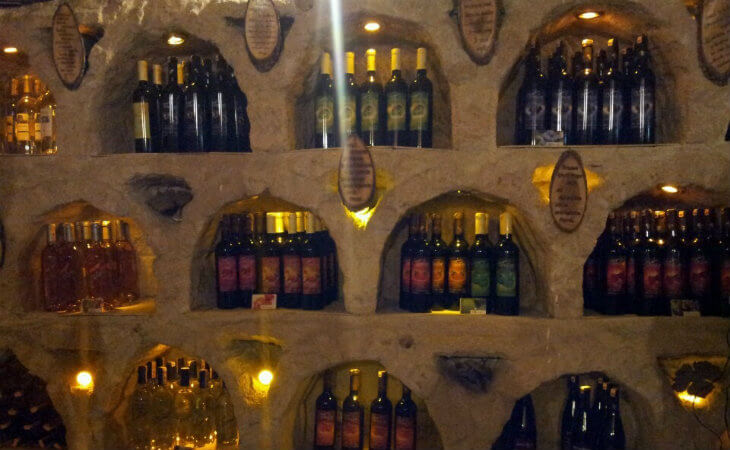Cappadocia not only offers a visual feast with its unique rock formations and historic underground cities, but also promises an unforgettable journey of flavor. In fact, this magical region stands out with its wine culture and even the history of Cappadocia wine.
To elaborate a little more on the subject, we should remind you that Cappadocia has been home to various civilizations throughout history. This shows that the city has a long history in wine production. Wine vineyards grow in the shadow of fairy chimneys and meet the unique climate and soil structure of the region, and the adventure of Cappadocia’s wine history begins for visitors.
So, how about going into a little more detail?
If your answer is “yes”, don’t forget to read the rest of the article!
The Origins of Wine Production in Cappadocia
When it comes to Cappadocia wineries, there is no one who hasn’t heard of these delicious places, but all this historical flavor goes back further than you might think. Let’s tell a little story about this history and give a brief introduction:
The climate and soil of ancient Cappadocia was ideal for growing grapes. This encouraged wine production in the region and shaped the wine culture of Cappadocia. During the Roman Empire, Cappadocian wines rose to prominence and played a major role in trade. Later, during the Middle Ages, wine production in Cappadocia remained important. Especially monasteries were the center of wine production and contributed to the regional economy. However, during the Ottoman Empire, wine production became difficult due to pressures and was replaced by other agricultural products.
Of course, this cannot be considered a permanent transition because, as you know, wine production still continues in today’s Cappadocia. But before moving on to today’s modern world, it is worth looking at the ancient period in more detail.
Viticulture and Wine Culture in Antiquity
In antiquity, viticulture and wine culture played an important role in the daily life of many civilizations. Especially in Mesopotamian, Ancient Greek, Roman and Persian cultures, vineyards and wine production were very important economic activities.
In Mesopotamia, detailed information about vineyards and wine making can be found in the written sources of the Sumerians. This civilization frequently used wine both in religious rituals and in daily life. In Ancient Greece, wine was of great importance as part of social interaction, symbolism and art. Especially during festivals dedicated to Dionysus, wine consumption was at the forefront. It is even possible to observe historical evidence of this in many churches and monasteries in Cappadocia.
On the other hand, wine culture was an indispensable part of daily life in Ancient Rome. As the Roman Empire expanded, wine production and trade became an important economic sector. There was a similar trend in ancient Persian culture, where vineyards were considered a symbol of luxury and prosperity.
In these civilizations, grape harvesting and wine making were carefully planned activities. Ancient vessels such as amphorae were used to store and transport wine. Wine was not only a drink, but also of cultural and religious significance.
Therefore, we can say that viticulture and wine culture in antiquity laid the foundations of today’s wine industry and is the only element that forms the Cappadocian wine context.
Fairy Chimneys and Wine Climate
As we have repeated many times and as you know, fairy chimneys are unique rock formations formed by the effects of wind and water erosion over countless years. Therefore, while the nature of this geography leaves the traces of wind and rain on the rock formations, the grapes grown here also allow the production of wines with a unique flavor profile. On the other hand, the fact that the grapes are produced on barren, waterless soils is another advantage that makes Cappadocia wines valuable worldwide.
The combination of the aesthetic dance of nature and wine production in this unique geography makes Cappadocia a destination that appeals to both visual and taste senses. The fairy chimneys and the wine climate form parts of a fascinating story, making it possible to not only see, but also to feel.
Cappadocia Wine Production Techniques
Winemaking in Cappadocia has become famous for the quality of white wines produced from Emir grapes, which are indigenous to the region. Because especially in the 1980s, the wines produced here managed to make a name for themselves with very famous brands. But when it comes down to it, Cappadocia wine tasting owes its fame mainly to its climate and mystical atmosphere. In fact, the wine production techniques practiced in Cappadocia depend exactly on these points.
Let’s explain:
As you might expect, wine production starts with the grape harvest. Cappadocia’s winemakers make a quality start by using carefully selected grapes from local vineyards. The harvest is meticulously carried out when the grapes have reached optimum ripeness. This is a critical stage to achieve the complex aromas and balanced structure of the wines.
Then comes the second and most important stage, traditional production. In Cappadocia wine production, modern technology is skillfully combined with traditional production methods. Grape crushing is done using modern pressing machines, while the fermentation process usually takes place in traditional pots instead of new generation concrete tanks. In addition, almost all of the wines are left to rest in caves carved into the rocks. This ensures that the wines meet modern standards while retaining the traditional Cappadocian flavor.
The final cellar secrets are often hidden in wooden barrels or Avanos pottery. In fact, winemakers in Cappadocia often prefer oak barrels. The wines that wait in these barrels for a long time are enriched with notes from the essence of the wood and gain a complex structure.
Wine Traditions in Cappadocia
The wine traditions of Cappadocia are integrated into the rich cultural heritage of the region. These traditions are not just a drink, but an invitation to discover the unique flavors of Cappadocia. The region is also notable for its traditional practices in wine production and local culture.
Some tips on Cappadocia’s wine-related traditions can be found in the subheadings below.
1. Grape Festival
Cappadocia’s wine tradition is often crowned with the traditional Grape Festival. This festival usually takes place in September and invites locals to celebrate the local grape harvest and winemaking. Full of colorful costumes, traditional dances and, of course, delicious Cappadocian wines, this festival is a celebration of the region’s wine culture.
2. Narince Vineyards
Narince, one of Cappadocia’s famous grape varieties, has a special place in the region’s wine tradition. This grape variety is particularly preferred for white wines and is one of the elements that make up the characteristic flavor profile of Cappadocian wines.
3. Wine Picnics at Sunset
The unique geography of Cappadocia is also famous for its sunset views. For this reason, especially in recent years, wine picnics held at sunset are very popular. Because at these specially organized picnics, visitors have the opportunity to experience the special flavors of local wines while enjoying the unique view of the region under the breeze of the soft wind. In short, this experience in the mystical atmosphere of Cappadocia offers a sunset adventure full of unforgettable memories.


